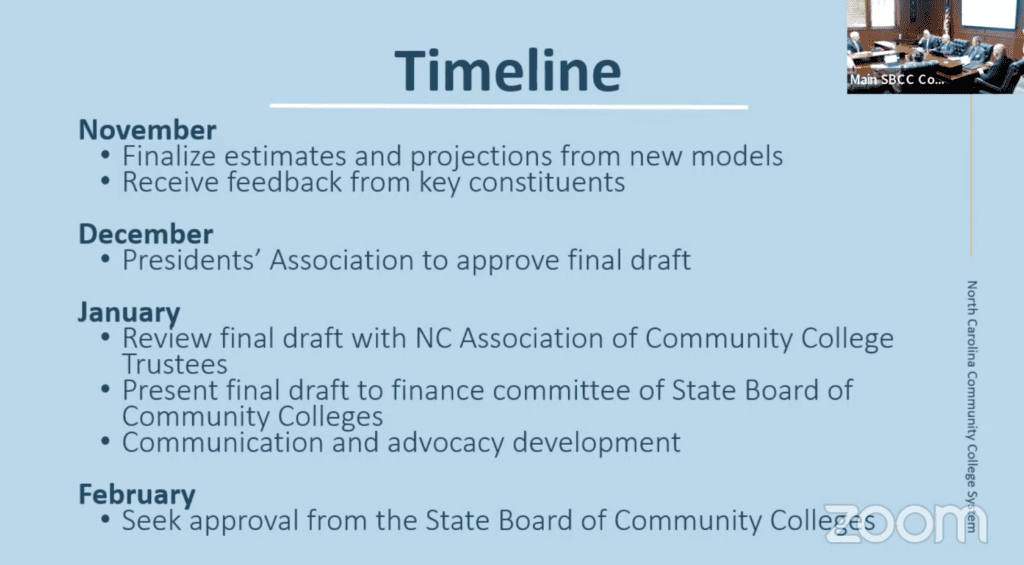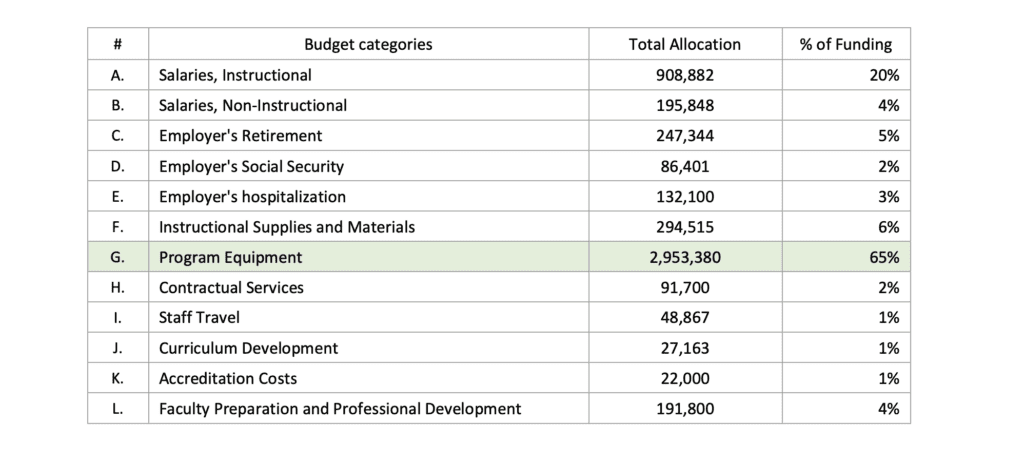North Carolina System Proposes New Funding Model for Community Colleges
The formula was last updated in 2013.

Get stories like this delivered straight to your inbox. Sign up for The 74 Newsletter
N.C. community college leaders have long called for an update to the state funding formula for community colleges, which was created in 2010 and last updated in 2013.
In August, the N.C. Community College System (NCCCS) officially started work to develop a modernized funding model ahead of the legislative short session with the goal of creating a more flexible, workforce-friendly system. On Nov. 16, the State Board of Community Colleges heard an update on that work from NCCCS Chief Financial Officer Dr. Phillip Price, Richmond Community College President Dr. Dale McInnis, and Lenoir Community College President Dr. Rusty Hunt.
McInnis, who is part of a 16-person work group for the project with Price and Hunt, said the team will bring a more detailed plan to the Board in January after the N.C. Association of Community College Presidents votes on it in December. The full Board is set to vote on the modernization plan in February.
“I couldn’t be more proud of where we’ve arrived at this point in time. I think this is a game changer for our system,” NCCCS President Dr. Jeff Cox said. “It answers the call that I think we’re hearing from our legislature and our governor about the community colleges’ critical role in meeting the workforce needs of the future of our state. …It aligns our system in a way we’ve just never been before.”
The vast majority of funding for the state’s 58 community colleges comes from state appropriations, with $1.5 billion allocated each year of this biennium.
The system’s current funding model allocates resources to the colleges in proportion to the number of full-time equivalent (FTE) students they enroll in each of their programs.
The majority of state funding falls into the instructional category and is distributed using a formula based on FTE student enrollment. One FTE is equivalent to 512 hours of instruction. Colleges are funded in arrears, meaning they receive funding based on the higher of the current year’s FTE or an average of the previous two years.
Certain courses receive more state funds than others based on a four-tiered funding model.
The work group is proposing to change the current FTE tiers to “workforce sectors” to move toward a labor-market driven model of community college programs. Under this model, all curriculum and continuing education (CE) courses would reside in the same workforce sector. A nursing curriculum and nursing CE course would be funded the same way, for example.
The sectors largely focus on health care, technology, and trades. Courses not on this list would be held harmless, the work group said, and retain their same value, just not labeled as tiers. There would be another catch-all sector for transfer and general education courses.

In addition to instructional funding based on FTE, colleges receive a base allocation for institutional and academic support, which includes additional funding for multi-campus centers. They also receive a small amount of performance-based funding.
The NCCCS modernization plan also includes three other focus areas beyond the proposed workforce sectors, listed below.
- Institutional and academic support base funding. “The base model has good bones,” Hunt said, “but it did need some modernizing.” This base funding largely goes toward salaries and benefits but can also be used toward other instructional costs. The NCCCS would like to see the base amount for “other costs,” which was set decades ago, increased to account for inflation.
- Enrollment increase reserve. The current enrollment growth reserve was implemented in 2010 in response to the large number of students enrolling in community colleges after the Great Recession. The system wants to request non-recurring funds for a fixed per-FTE amount for any colleges that go over the enrollment threshold set by their FTE for the fiscal year. The system would then like to build replenishment of the fund into the recurring enrollment growth fund in the state budget.
- Excess tuition retention. Excess tuition receipts currently fund the enrollment increase reserve. The NCCCS work group would like to change that, allowing excess tuition receipts to return to the college which generated them but only on years when the system as a whole generates excess receipts.
“One of the great things about our system is our open door. We’re registering students up until the day classes start across the system in every college,” McInnis said. “One of the challenges with that is our enrollment can fluctuate, and it’s usually directly proportionate to changes in the labor market and the economy. …What we’re looking for is an alternative to deal with the next wave of surges in enrollment.”
The group considered including headcount data in the funding model, instead of FTE, to account for an increase of part-time students but decided college data did not support the change.
The NCCCS work group also discussed ways to incentivize partnerships and improve the multi-campus model, McInnis said, but those factors are not yet ready for implementation.
You can read more about the current funding model for community colleges in this March EdNC report.

Implementation of budget, accreditation changes
Last month, the State Board began operationalizing items in the new state budget for community colleges.
At that meeting, the Board approved an initial budget allocation package that contained the 4% salary increase in 2023-24 and other employee benefit increases, funds for enrollment growth, and additional funds for basic skills and child care grants. In a separate item, the Board also approved allocations for up to $14.2 million to complete the rural broadband project.
On Nov. 17, the Board approved allocations for several additional budget items for 2023-24, listed below.
- $1.5 million allocation to support the Finish Line Grants program. Through this program, eligible students can receive up to $1,000 per semester for an unanticipated financial hardship. To be eligible, students must be in good academic standing as defined by the college and have completed at least 25% of their degree or credential program.
- $31.7 million in each year of the biennium for faculty recruitment and retention, which is limited to faculty “with a majority teaching load in Tier IA or IB courses.” You can view the allocations on page 61 of the agenda.
- More than $7 million each year of the biennium to fund a nursing faculty salary adjustment. Starting pay for nursing faculty will be increased by 10%, and other nursing faculty may receive salary increases up to 15%.
- An initial allocation of $5.3 million to community colleges for the High-Cost Workforce Start-Up Fund Program to support the start-up of Tier 1A and Tier 1B health care workforce programs offered at N.C. community colleges. You can read the allocations for 11 new programs on page 68 of the agenda.
- $200 million in State Capital Improvement Infrastructure Funds (SCIF) over the biennium. These funds will go to nearly two-thirds of the state’s community colleges, which marks an unprecedented number of individual allocations to community colleges. You can view the allocation list on page 75 of the agenda. You can also view highlights from those allocations in EdNC’s report on community college items in the budget.
NCCCS Senior Vice President and Chief Academic Officer Dr. Brian Merritt also gave the Board a brief update on accreditation provisions in a bill which made various statutory updates.
Those provisions require colleges and universities to change accreditors every accreditation cycle, which lasts 10 years. The new law does not allocate any funding toward the process, which Merritt said will involve a lot of expenses and time for colleges.
“This is going to be a big lift for our institutions, especially our rural institutions,” he said. “There is a lot of anxiety across our system about this.”
The state’s 58 colleges are at different stages in their accreditation cycles, Cox said. The law does allow colleges to stay with their current accreditor for consecutive cycles if they are “not granted candidacy status” from another accreditor three years before the current accreditation expires.
There are six accrediting agencies for higher education listed in the law.
The NCCCS is working to provide guidance to the colleges, Cox and Merritt said, and is working with the UNC System to provide aligned guidance. Then, the system will meet with the U.S. Department of Education (DOE) to receive their guidance, as the DOE must approve any change in accreditors before a college can start that cycle.
EdNC will provide a more in-depth update on these accreditation changes and their impact soon.
Data on student supports
The Board received several annual reports on important initiatives to support students and programs.
First, the Board discussed the Year 2 report of the RISE Up Training and Credentialing Program. That program was funded and mandated by the General Assembly in 2021 and directs the NCCCS to collaborate with the North Carolina Retail Merchants Association (NCRMA) and Retail Consumer Alliance Foundation (RCA) to teach foundational skills to students attending Cooperative Innovative High Schools (CIHS).
Students who complete the mostly online program will earn industry credentials in the following areas: retail industry fundamentals, customer service/sales, inventory management/profitability, supply chain warehouse/inventory, and logistics.
Since February 2022, Lenoir Community College has served as the lead college for the program.
In June 2022, the NCRMA requested a technical budget correction which expanded the program to any student enrolled in a N.C. community college. The new state budget expands access further to any student who meets eligibility.
As of August 2023, 279 credentials were allocated across four courses.
“Program access is expected to expand which will allow additional credentials to be earned,” the report says.
You can read the RISE report starting on page 3 of the meeting agenda.
The Board also discussed the Year 2 legislative report on the High-Cost Workforce Start-Up Fund Program. In 2021, the General Assembly allocated $5.2 million “to assist N.C. community colleges in starting new programs in high-demand career fields that require significant start-up funds,” the report says. The new budget also allocated funding to the project.
Per the report, 46 colleges submitted applications for the funds, and 14 successfully received the money. A final report on how the grant money was spent is due to the system office by July 16, 2024.
Most of the funding (65%) was used to purchase program equipment, the report says. You can view the other budget categories below.

Finally, the Board discussed the summary of the 2022-23 N.C. Child Care Grant Program for community college students.
Since 1993, the state has allocated money to the community college system to help students afford child care.
During the 2022-23 fiscal year, colleges self-reported $2.5 million in N.C. Child Care Grant aid to students. Per the report, this represents an increase of $641,640 from the nearly $1.9 million disbursed during the previous year.
The new budget also provides $1.2 million in annual recurring funding for the program.
Even more is needed to make a dent in the student need, community college leaders previously told EdNC, along with wider eligibility for students. A lack of affordable child care can also make it difficult for students to successfully spend the money, sometimes leaving colleges with unexpended grants.
In the 2022-23 fiscal year, the grant assisted 744 students, according to the report, an increase of 68 students from the year before.
However, colleges reported inability to serve 631 students who applied for the grant. Colleges attributed the inability to serve more students due to students not meeting the eligibility/enrollment requirements for the grant or running out of grant funds for the year.
You can view that report on page 125 of the agenda packet.

New Davidson-Davie President and Board members
- The Board approved the final candidate for the president at Davidson-Davie Community College on Nov.17, and the college soon after announced Jenny Varner as its new president. Varner has been serving as acting president since Darrin Hartness, who served as president since 2019, died from esophageal cancer in July.
- The system is looking for four other community college presidents at Alamance Community College, Martin Community College, McDowell Technical Community College, and Wilkes Community College. The personnel committee is set to meet again ahead of next month’s full Board meeting to discuss those searches.
- Three new Board members, appointed by lawmakers on Oct. 24, were sworn in on Nov. 17. Those new members include Paula Benson, director of advocacy group Wilson Forward; Raleigh developer John Kane; and business leader Geoffrey Lang. Each of the new members has previous experience serving on education boards. Their terms expire June 30, 2025.
- The Board approved metrics for the performance evaluation of Cox’s first year as system president, which outlines requirements for an end-of-year bonus. You can view that document on page 35 of the meeting agenda. The Board approved its Year 1 Goals for Cox at its September meeting.
- The Board approved up to $1.52 million to provide service management software for five Enterprise Resource Planning (ERP) modernization pilot colleges, from Dec. 1, 2023 to May 31, 2026. In September, the Board approved “significant reorganization” of system positions to support that modernization work.
- Tony Pile, the Board’s student member and president of the North Carolina Comprehensive College Student Government Association (N4CSGA), said N4CSGA is working with local SGA chapters to advocate for continued student voice on local boards of trustees. The new budget included several significant changes to governance at the state and local level for community colleges. While the State Board still has a standing student member, the budget made student representation on local boards optional for colleges.
- The N4CSGA will host a mental health campaign in January, Pile said. Many of the state’s community colleges are working to bolster their mental health resources.
The full Board will meet next on Dec. 15 for a virtual meeting.
This article first appeared on EducationNC and is republished here under a Creative Commons license.
Get stories like these delivered straight to your inbox. Sign up for The 74 Newsletter

;)